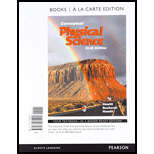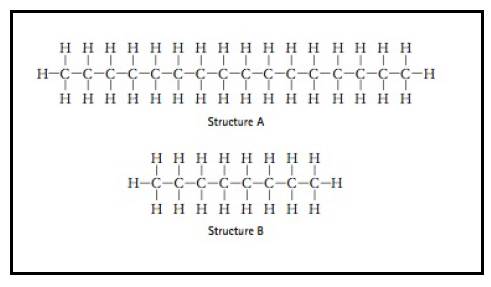
Conceptual Physical Science, Books a la Carte Edition; Modified Mastering Physics with Pearson eText -- ValuePack Access Card -- for Conceptual Physical Science (6th Edition)
6th Edition
ISBN: 9780134466927
Author: Paul G. Hewitt, Leslie A. Hewitt
Publisher: PEARSON
expand_more
expand_more
format_list_bulleted
Question
Chapter 15, Problem 77E
To determine
Of the two structures given below, the one which belong to the structure of gasoline and the other one that belong to structure of motor oil.

Expert Solution & Answer
Want to see the full answer?
Check out a sample textbook solution
Students have asked these similar questions
Can someone help
Can someone help me
3. Four identical small masses are connected in a
flat perfect square. Rank the relative rotational
inertias (IA, IB, IC) about the three axes of
rotation shown. Axes A and B are in the plane of
the square, and axis C is perpendicular to the
plane, through mass m1.
ΙΑ
IB
m2
m1
m3
Ic
m4
(a) IA
Chapter 15 Solutions
Conceptual Physical Science, Books a la Carte Edition; Modified Mastering Physics with Pearson eText -- ValuePack Access Card -- for Conceptual Physical Science (6th Edition)
Ch. 15 - How many electrons can occupy the first shell? How...Ch. 15 - Which electrons are represented by an electron-dot...Ch. 15 - Prob. 3RCQCh. 15 - How does an ion differ from an atom?Ch. 15 - To become a negative ion, does an atom lose or...Ch. 15 - Why does the fluorine atom tend to gain only one...Ch. 15 - Prob. 7RCQCh. 15 - Suppose an oxygen atom gains two electrons to...Ch. 15 - Prob. 9RCQCh. 15 - Do metals more readily gain or lose electrons?
Ch. 15 - What is an alloy?Ch. 15 - What is a native metal?Ch. 15 - Prob. 13RCQCh. 15 - Prob. 14RCQCh. 15 - Within a neutral molecule, how many covalent bonds...Ch. 15 - Prob. 16RCQCh. 15 - Prob. 17RCQCh. 15 - Prob. 18RCQCh. 15 - Prob. 19RCQCh. 15 - How can a molecule be nonpolar when it consists of...Ch. 15 - Why do nonpolar substances boil at relatively low...Ch. 15 - Which is more symmetrical: a polar molecule or a...Ch. 15 - Why dont oil and water mix?Ch. 15 - Prob. 24RCQCh. 15 - Which is stronger: the ion-dipole attraction or...Ch. 15 - What is a hydrogen bond?Ch. 15 - Are induced dipoles permanent?Ch. 15 - Prob. 31TASCh. 15 - What is the electric charge on the calcium ion in...Ch. 15 - Prob. 33TASCh. 15 - Prob. 34TASCh. 15 - Rank these bonds in order of increasing polarity:...Ch. 15 - Prob. 36TARCh. 15 - Prob. 37TARCh. 15 - Prob. 38TARCh. 15 - Prob. 39ECh. 15 - Prob. 40ECh. 15 - How many more electrons can fit within the valence...Ch. 15 - Prob. 42ECh. 15 - What happens when hydrogens electron gets close to...Ch. 15 - Prob. 44ECh. 15 - Why does an atom with few valence electrons tend...Ch. 15 - Why is it so easy for a magnesium atom to lose two...Ch. 15 - Why doesnt the neon atom tend to lose or gain any...Ch. 15 - Why does an atom with many valence electrons tend...Ch. 15 - Sulfuric acid, H2SO4, loses two protons to form...Ch. 15 - Prob. 50ECh. 15 - Which should be more difficult to pull apart: a...Ch. 15 - Prob. 52ECh. 15 - Given that the total number of atoms on our planet...Ch. 15 - An artist wants to create a metal sculpture using...Ch. 15 - Two fluorine atoms join together to form a...Ch. 15 - How are metallic bonds similar to ionic bonds? How...Ch. 15 - What drives an atom to form a covalent bond: its...Ch. 15 - Atoms of nonmetallic elements form covalent bonds,...Ch. 15 - Prob. 59ECh. 15 - Prob. 60ECh. 15 - Write the electron-dot structure for the covalent...Ch. 15 - Prob. 62ECh. 15 - In each molecule, which atom carries the greater...Ch. 15 - Which is more polar: a sulfur-bromine (S-Br) bond...Ch. 15 - True or False: The greater the nuclear charge of...Ch. 15 - True or False: The more shells in an atom, the...Ch. 15 - Water, H2O, and methane, CH4, have about the same...Ch. 15 - In the figure on the next page, the molecule from...Ch. 15 - Prob. 69ECh. 15 - Three kids sitting equally apart around a table...Ch. 15 - Which is stronger: the covalent bond that holds...Ch. 15 - The charges with sodium chloride are all...Ch. 15 - Prob. 73ECh. 15 - Prob. 74ECh. 15 - Prob. 75ECh. 15 - A thin stream of water is pulled to a rubber...Ch. 15 - Prob. 77ECh. 15 - Prob. 1RATCh. 15 - Prob. 2RATCh. 15 - Which would you expect to have a higher melting...Ch. 15 - Why are ores so valuable? (a) They are sources of...Ch. 15 - In terms of the periodic table, is there an abrupt...Ch. 15 - A hydrogen atom does not form more than one...Ch. 15 - When nitrogen and fluorine combine to form a...Ch. 15 - Prob. 8RATCh. 15 - Prob. 9RATCh. 15 - Iodine, I2, has a higher melting point than...
Knowledge Booster
Similar questions
- Consider the circuit shown in the figure below. (Assume L = 5.20 m and R2 = 440 Ω.) (a) When the switch is in position a, for what value of R1 will the circuit have a time constant of 15.4 µs? (b) What is the current in the inductor at the instant the switch is thrown to position b?arrow_forwardCan someone helparrow_forwardCan someone help mearrow_forward
- A particle in a box between x=0 and x=6 has the wavefunction Psi(x)=A sin(2πx). How muchenergy is required for the electron to make a transition to Psi(x)= A’ sin(7π x/3). Draw anapproximate graph for the wavefunction. Find A and A'arrow_forwardA proton is moving with 10^8 m/s speed. Find the De Broglie wavelength associated with theproton and the frequency of that wave.arrow_forwardFind the wavelength of the photon if a (Li--) electron makes a transition from n=4 to n=3. Findthe Bohr radius for each state.arrow_forward
- A photon with wavelength 3000 nm hits a stationary electron. After the collision electron isscattered to 60 degrees. Find the wavelength and frequency of the scattered photon.arrow_forwardA metal has threshold frequency 10^15. Calculate the maximum kinetic energy of the ejectedelectron if a laser beam with wavelength 1.5 10^-7 m is projected on the metal.arrow_forwardDetermine the direction of the vector V, B, or ♬ that is missing from the pair of vectors shown in each scenario. Here, u is the velocity vector of a moving positive charge, B is a constant and uniform magnetic field, and F is the resulting force on the moving charge. 1. 2. 3. B OB F 4. ↑F F 5. 怔 ↑ ↑F Answer Bank 6. ↑ TE Farrow_forward
- Two point charges (+9.80 nC and -9.80 nC) are located 8.00 cm apart. Let U=0 when all of the charges are separated by infinite distances. What is the potential energy if a third point charge q=-4.20 nC is placed at point b? 8.00 cm 8.00 cm 4.00 +4.00 +4.00- cm cm cm HJarrow_forward! Required information Two chloride ions and two sodium ions are in water, the "effective charge" on the chloride ions (CI¯) is −2.00 × 10-21 C and that of the sodium ions (Na+) is +2.00 x 10-21 C. (The effective charge is a way to account for the partial shielding due to nearby water molecules.) Assume that all four ions are coplanar. CT Na+ Na+ 30.0° 45.0% с сг L. where a = 0.300 nm, b = 0.710 nm, and c = 0.620 nm. What is the direction of electric force on the chloride ion in the lower right-hand corner in the diagram? Enter the angle in degrees where positive indicates above the negative x-axis and negative indicates below the positive x-axis.arrow_forwardA pendulum has a 0.4-m-long cord and is given a tangential velocity of 0.2 m/s toward the vertical from a position 0 = 0.3 rad. Part A Determine the equation which describes the angular motion. Express your answer in terms of the variable t. Express coefficients in radians to three significant figures. ΜΕ ΑΣΦ vec (t)=0.3 cos (4.95t) + 0.101 sin (4.95t) Submit Previous Answers Request Answer × Incorrect; Try Again; 6 attempts remainingarrow_forward
arrow_back_ios
SEE MORE QUESTIONS
arrow_forward_ios
Recommended textbooks for you
 Physics for Scientists and Engineers with Modern ...PhysicsISBN:9781337553292Author:Raymond A. Serway, John W. JewettPublisher:Cengage Learning
Physics for Scientists and Engineers with Modern ...PhysicsISBN:9781337553292Author:Raymond A. Serway, John W. JewettPublisher:Cengage Learning An Introduction to Physical SciencePhysicsISBN:9781305079137Author:James Shipman, Jerry D. Wilson, Charles A. Higgins, Omar TorresPublisher:Cengage Learning
An Introduction to Physical SciencePhysicsISBN:9781305079137Author:James Shipman, Jerry D. Wilson, Charles A. Higgins, Omar TorresPublisher:Cengage Learning Modern PhysicsPhysicsISBN:9781111794378Author:Raymond A. Serway, Clement J. Moses, Curt A. MoyerPublisher:Cengage Learning
Modern PhysicsPhysicsISBN:9781111794378Author:Raymond A. Serway, Clement J. Moses, Curt A. MoyerPublisher:Cengage Learning Foundations of Astronomy (MindTap Course List)PhysicsISBN:9781337399920Author:Michael A. Seeds, Dana BackmanPublisher:Cengage Learning
Foundations of Astronomy (MindTap Course List)PhysicsISBN:9781337399920Author:Michael A. Seeds, Dana BackmanPublisher:Cengage Learning Stars and Galaxies (MindTap Course List)PhysicsISBN:9781337399944Author:Michael A. SeedsPublisher:Cengage Learning
Stars and Galaxies (MindTap Course List)PhysicsISBN:9781337399944Author:Michael A. SeedsPublisher:Cengage Learning


Physics for Scientists and Engineers with Modern ...
Physics
ISBN:9781337553292
Author:Raymond A. Serway, John W. Jewett
Publisher:Cengage Learning

An Introduction to Physical Science
Physics
ISBN:9781305079137
Author:James Shipman, Jerry D. Wilson, Charles A. Higgins, Omar Torres
Publisher:Cengage Learning

Modern Physics
Physics
ISBN:9781111794378
Author:Raymond A. Serway, Clement J. Moses, Curt A. Moyer
Publisher:Cengage Learning

Foundations of Astronomy (MindTap Course List)
Physics
ISBN:9781337399920
Author:Michael A. Seeds, Dana Backman
Publisher:Cengage Learning

Stars and Galaxies (MindTap Course List)
Physics
ISBN:9781337399944
Author:Michael A. Seeds
Publisher:Cengage Learning